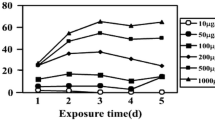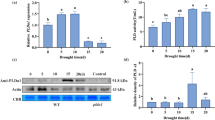Abstract
The functional state of the photosynthetic apparatus of flowering homoiochlorophyllous desiccation tolerant plant Haberlea rhodopensis during dehydration and subsequent rehydration was investigated in order to characterize some of the mechanisms by which resurrection plants survive drought stress. The changes in the CO2 assimilation rate, chlorophyll fluorescence parameters, thermoluminescence, fluorescence imaging and electrophoretic characteristics of the chloroplast proteins were measured in control, moderately dehydrated (50% water content), desiccated (5% water content) and rehydrated plants. During the first phase of desiccation the net CO2 assimilation decline was influenced by stomatal closure. Further lowering of net CO2 assimilation was caused by both the decrease in stomatal conductance and in the photochemical activity of photosystem II. Severe dehydration caused inhibition of quantum yield of PSII electron transport, disappearance of thermoluminescence B band and mainly charge recombination related to S2Q −A takes place. The blue and green fluorescence emission in desiccated leaves strongly increased. It could be suggested that unchanged chlorophyll content and amounts of chlorophyll–proteins, reversible modifications in PSII electron transport and enhanced probability for non-radiative energy dissipation as well as increased polyphenolic synthesis during desiccation of Haberlea contribute to drought resistance and fast recovery after rehydration.






Similar content being viewed by others
Abbreviations
- Ca:
-
Ambient air CO2 concentration
- Chl:
-
Chlorophyll
- Ci:
-
Intercellular CO2 concentration
- F v /F m :
-
Maximal quantum efficiency of photosystem II in the dark adapted state
- gs:
-
Stomatal conductance
- LHCI:
-
Light harvesting complex I
- LHCII:
-
Light harvesting complex II
- NPQ:
-
Non-photochemical quenching
- PSI:
-
Photosystem I
- PSII:
-
Photosystem II
- ΦPSII:
-
Quantum yield of photosystem II photochemistry in the light adapted state
- WC:
-
Water content
References
Alamillo JM, Bartels D (2001) Effects of desiccation on photosynthesis pigments and the ELIP-like dsp 22 protein complex in the resurrection plant Craterostigma plantagineum. Plant Sci 160:1161–1170
Alisson SD, Chang B, Randolph TW, Carpenter JF (1999) Hydrogen bonding between sugar and protein is responsible for inhibition of dehydration-induced protein unfolding. Arch Biochem Biophys 365:289–298
Apostol S, Viau AA, Tremblay N, Briantais J-M, Prasher S, Parent L-E, Moya I (2003) Laser-induced fluorescence signatures as a tool for remote monitoring of water and nitrogen stresses in plants. Can J Remote Sens 29:57–65
Bewley JD (1979) Physiological aspects of desiccation tolerance. Annu Rev Plant Physiol 30:195–238
Buschmann C, Langsdorf G, Lichtenthaler HK (2000) Imaging of blue, green, and red fluorescence emission of plants: an overview. Photosynthetica 38:483–491
von Caemmerer S, Farquhar GD (1981) Some relationships between the biochemistry of photosynthesis and the gas exchange of leaves. Planta 153:376–387
Crowe JH, Hoekstra FA, Nguyen KHN, Crowe LM (1996) Is vitrification involved in depression of the phase transition temperature in dry phospholipids. Biochim Biophys Acta 1280:187–196
Deng X, Hu Z-A, Wang H-X, Wen X-G, Kuang T-Y (2003) A comparison of photosynthetic apparatus of the detached leaves of the resurrection plant Boea hygrometrica with its non-tolerant relative Chirita heterotrichia in response to dehydration and rehydration. Plant Sci 165:851–861
Dilks TJK, Proctor MCF (1979) Photosynthesis, respiration and water content in bryophytes. New Phytol 82:97–114
Farrant JM, Sherwin HS (1998) Mechanisms of desiccation tolerance in seeds and resurrection plants. In: Taylor AG, Huang X-L (eds) Progress in seed research. Proceedings of 2nd International Conference on Seed Science and Technology, Geneva, NY, Communication Services of New York State Agricultural Experiment Station, pp 109–120
Farrant JM, Cooper K, Kruger LA, Sherwin HW (1999) The effect of drying rate on the survival of three desiccation-tolerant angiosperm species. Ann Bot 84:371–379
Farrant JM, Willigen CW, Loffell DA, Bartsch S, Whittaker A (2003) An investigation into the role of light during desiccation of three angiosperm resurrection plants. Plant Cell Environ 26:1275–1286
Georgieva K, Maslenkova L, Peeva V, Markovska Yu, Stefanov D, Tuba Z (2005) Comparative study on the changes in photosynthetic activity of the homoiochlorophyllous desiccation-tolerant Haberlea rhodopensis and spinach leaves during desiccation and rehydration. Photosynth Res 85:191–203
Hideg E, Juhasz M, Bornman JF, Asada K (2002) The distribution and possible origin of blue-green fluorescence in control and stressed barley leaves. Photochem Photobiol Sci 1:934–941
Hoekstra FA, Golovina EA, Buitink J (2001) Mechanisms of plant desiccation tolerance. Trends Plant Sci 6:431–438
Kaiser WM, Kaiser G, Schöner S, Neimanis S (1981) Photosynthesis under osmotic stress. Differential recovery of photosynthetic activities of stroma enzymes, intact chloroplast and leaf slices after exposure to high solute concentrations. Planta 153:430–435
Laemmli UK (1970) Cleavage of structural proteins during assembly of the head of bacteriophage T4. Nature 227:680–685
Lichtenthaler KH (1987) Chlorophylls and carotenoids: pigments of photosynthetic biomembranes. Methods Enzymol 148:350–382
Lichtenthaler HK, Babani F (2000) Detection of photosynthetic activity and water stress by imaging the red chlorophyll fluorescence. Plant Physiol Biochem 38:889–895
Lu C, Zhang J (1998) Effects of water stress on photosynthesis, chlorophyll fluorescence and photoinhibition in wheat plants. Aust J Plant Physiol 25:883–892
Mills WR, Joy KW (1980) A rapid method for isolation of purified, physiologically active chloroplasts, used to study the intracellular distribution of amino acids in pea leaves. Planta 148:75–83
Nash III TH, Reiner A, Demmig-Adams B, Kilian E, Kaiser WM, Lange OL (1990) The effect of atmospheric desiccation and osmotic water stress on photosynthesis and dark respiration of lichens. New Phytol 116:269–276
Peeva V, Maslenkova L (2004) Thermoluminescence study of photosystem II activity in Haberlea rhodopensis and spinach leaves during desiccation. Plant Biol 6:1–6
Proctor MCF, Tuba Z (2002) Poikilohydry and homoihydry: antithesis or spectrum of possibilities? New Phytol 156:327–349
Sárvári É, Nyitrai P (1994) Separation of chlorophyll–protein complexes by Deriphat polyacrylamide gradient gel electrophoresis. Electrophoresis 15:1067–1071
Sass L, Csintalan Zs, Tuba Z, Vass I (1996) Thermoluminescence studies on the function of photosystem II in the desiccation tolerant lichen Cladonia convoluta. Photosynth Res 48:205–212
Schwab KB, Schreiber U, Heber U (1989) Response of photosynthesis and respiration of resurrection plants to desiccation and rehydration. Planta 177:217–227
Scotnica J, Matouskova M, Naus J, Lazar D, Dvorak L (2000) Thermoluminescense and fluorescence study of changes in photosystem II photochemistry in desiccating barley leaves. Photosynth Res 65:29–40
Scott P (2000) Resurrection plants and the secrets of eternal leaf. Ann Bot 85:159–166
Smirnoff N (1993) The role of active oxygen in the response of plants to water deficit and desiccation. New Phytol 125:27–58
Tuba Z, Lichtenthaler HK, Csintalan Zs, Nagy Z, Szente K (1994) Reconstitution of chlorophylls and photosynthetic CO2 assimilation upon rehydration in the desiccated poikilochlorophyllous plant Xerophyta scabrida. Planta 192:414–420
Tuba Z, Csintalan Zs, Proctor MCF (1996) Photosynthetic responses of a moss, Tortula ruralis (Hedw.) Gaertn. et al. ssp. ruralis, and the lichens Cladonia convoluta (Lam.) P. Cout. and C. furcata (Huds.) Schrad. to water deficit and short periods of desiccation, and their eco-physiological significance: a baseline study at present-day CO2 concentration. New Phytol 133:353–361
Tuba Z, Proctor MCF, Csintalan Zs (1998) Ecophysiological responses of homoiochlorophyllous and poikilochlorophyllous desiccation tolerant plants: a comparison and an ecological perspective. Plant Growth Regul 24:211–217
Vass I, Govindjee (1996) Thermoluminescence from the photosynthetic apparatus. Photosynth Res 48:117–126
Vecchia FD, Asmar TE, Calamassi R, Rascio N, Vazzana C (1998) Morphological and ultrastructural aspects of dehydration and rehydration in leaves of Sporobolus stapfianus. Plant Growth Regul 24:219–228
Zeinalov Yu, Maslenkova L (1996) A computerised equipment for thermoluminescence investigations. Bulg J Plant Physiol 22:88–94
Acknowledgments
This study was supported by NATO grand for K. Georgieva and by Bulgarian Fond “Scientific Investigations” (Project B-1203).
Author information
Authors and Affiliations
Corresponding author
Rights and permissions
About this article
Cite this article
Georgieva, K., Szigeti, Z., Sarvari, E. et al. Photosynthetic activity of homoiochlorophyllous desiccation tolerant plant Haberlea rhodopensis during dehydration and rehydration. Planta 225, 955–964 (2007). https://doi.org/10.1007/s00425-006-0396-8
Received:
Accepted:
Published:
Issue Date:
DOI: https://doi.org/10.1007/s00425-006-0396-8




